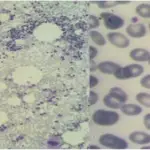Microangiopathic hemolytic anemia is the loss of red blood cells through the destruction caused by factors in the small blood vessels.
What is the Pathology of Microangiopathic Hemolytic Anemia?
The pathology of microangiopathic hemolytic anemia is:
-Etiology: The cause of microangiopathic hemolytic anemia is the factors in the small blood vessels.
-Genes involved: None.
-Pathogenesis: The sequence of events that lead to microangiopathic hemolytic anemia includes the formation of a fibrin mesh due to increased activation of the system of coagulation.
-Histology: The histology associated with microangiopathic hemolytic anemia shows fragmented, distorted red blood cells (schistocytes) on the peripheral blood smear.
How does Microangiopathic Hemolytic Anemia Present?
Patients with microangiopathic hemolytic anemia typically affect females present at the age range of 20-50 years. The symptoms, features, and clinical findings associated with microangiopathic hemolytic anemia include schistocytes, bleeding, thrombosis, fatigue, pallor, palpitations, jaundice, and scleral icterus.
How is Microangiopathic Hemolytic Anemia Diagnosed?
Microangiopathic hemolytic anemia is diagnosed using a complete blood count.
How is Microangiopathic Hemolytic Anemia Treated?
Microangiopathic hemolytic anemia is treated with plasmapheresis and corticosteroids.
What is the Prognosis of Microangiopathic Hemolytic Anemia?
The prognosis of microangiopathic hemolytic anemia is poor with a mortality rate of 90% if left untreated.



